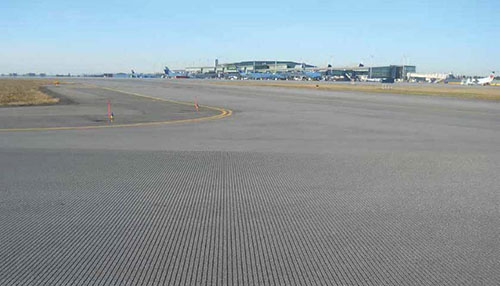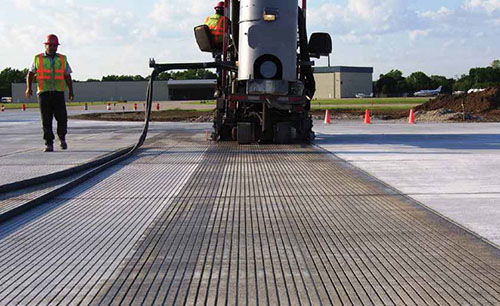Ottawa Int'l Sets Precedent With Grooved Runway
 When Ottawa International Airport (YOW) added grooves to one of its main runways last summer, it became the first major Canadian airport to do so.
When Ottawa International Airport (YOW) added grooves to one of its main runways last summer, it became the first major Canadian airport to do so.
The $360,000 project was undertaken to improve aircraft braking and handling in wet conditions. After operating on the grooved runway for more than a year, airlines are apparently pleased with the change. Response has been so positive, in fact, that the Ontario airport plans to groove its longest runway next summer.
Marc Gervais, YOW's director of airside operations, explains the research and consideration that preceded the $360,000 project: "We were in the planning process for the rehabilitation of our major runways, and we wanted to ensure that we would reconstruct them to the highest safety standard. Adding grooves, which had already been done by many of our U.S. counterparts, was one option we thought would be beneficial, even though runway grooving is not required by regulation in Canada."
 factsfigures factsfiguresProject: Runway Grooving Location: Ottawa (Ontario) Int'l Airport Annual Operations: 168,000 Runway Grooved: 7-25 Length: 8,000 ft. Width: 200 ft. Approx. Cost: $360,000 Project Duration: 10 days Contractor: Cardinal Int'l Grooving & Grinding Post-Project Performance Study: LPS AVIA Consulting Key Benefits: Increasing safety for aircraft landing on the often-wet runway For More Information: Consult FAA Advisory Circular 150/5320-12C |
YOW personnel consequently contacted peers at airports in Boston, New York, Minneapolis, Chicago and other U.S. cities with climates similar to Ottawa's. In addition to seeking general feedback about the durability and overall characteristics of grooved runways, they were especially curious about how grooves perform during winter - an initial concern raised by management.
In addition to plenty of rain, YOW typically receives about 92 inches of snow and five or six ice storms per year, Gervais reports.
"Fortunately, we had input from a much smaller airport in Canada (Norman Wells Airport, in the Northwest Territories) that showed no adverse winter effects," he notes. "That facility regularly experiences bad weather, and added grooves a few years ago."
With support from senior management, the board of directors and the airport's major carriers, YOW added grooving to its existing runway rehabilitation plans.
Crews installed grooves the entire length of Runway 7-25 during summer 2013 - a full year after the 8,000-foot runway had been reconstructed. The lapse between the projects allowed time for the asphalt to fully cure. Contractors followed the standard FAA configuration of 1/4-inch wide, 1/4-inch deep grooves, spaced 11/2 inches apart, center to center. The project took 10 days and cost approximately $360,000.

"Costs for grooving depend on the hardness of the surface being grooved," explains Gervais, noting that concrete runways are the most expensive to groove. "With other factors, the price can range from $1.15 per square meter to $4 per square meter."
Post-project research conducted last winter by LPS AVIA Consulting validated YOW's decision to groove Runway 7-25. "The report concluded that the grooved runway has had a beneficial effect on aircraft braking performance without negatively impacting runway friction in winter," Gervais summarizes.
Why it Works
John Roberts, executive director of the International Grooving and Grinding Association, emphasizes the safety advantages of runway grooving projects. "When a pilot is landing on a wet runway and steps on the brakes, there is much more even braking with a grooved runway," Roberts explains. "Grooving minimizes the potential for hydroplaning, and delivers the best possible overall ground handling and stopping characteristics that today's state-of-the-art technology can provide."
The nature of the work required to add grooves allows airports to keep runways open intermittently throughout construction. "If you have an 8,000-foot runway, you can do the grooving in sections each night for a few nights, until completion. The runway can be used that morning, without missing a beat," he adds.
Some airports, however, prefer to close a runway to allow crews longer work periods. "If you are able to completely shut down a runway for a few days, that obviously lessens project completion time," Roberts says.
Grooving operations can occur in most weather conditions, including driving rainstorms, he adds. The exception is temperatures at or below freezing, due to the use of water to cool the cutting blades.
Several factors affect project cost, Roberts notes:
• Available work periods. Allowing a contractor to work 24 hours a day instead of only eight allows for better equipment utilization and speeds project completion.
• Type of surface. Concrete runways require more time and higher-quality diamond blades because they contain harder aggregate than asphalt surfaces.
• Runway length. Some airports reduce costs by adding grooves only to the ends of a runway.
Projects funded by the FAA, however, must groove the entire length.
Roberts encourages airport managers to consider the safety enhancements as well as the costs of runway grooving. This is especially important for managers at airports in Canada and Europe, where grooved runways are less common, and misperceptions still prevail about grooves complicating winter operations and maintenance, he notes.
"Hopefully, the success shown at the Ottawa airport and other hubs located in the northern United States will help other airport executives convince their boards that grooving is an economical and time-tested investment in safety," Roberts comments.
Based on the way Runway 7-25 performed during the particularly harsh winter of 2013-2014, YOW plans to repeat the grooving process next summer on its recently reconstructed Runway 14-32, which is 10,000 feet long.
FREE Whitepaper
PAVIX: Proven Winner for All Airport Concrete Infrastructure
International Chem-Crete Corporation (ICC) manufactures and sells PAVIX, a unique line of crystalline waterproofing products that penetrate into the surface of cured concrete to fill and seal pores and capillary voids, creating a long lasting protective zone within the concrete substrate.
Once concrete is treated, water is prevented from penetrating through this protective zone and causing associated damage, such as freeze-thaw cracking, reinforcing steel corrosion, chloride ion penetration, and ASR related cracking.
This white paper discusses how the PAVIX CCC100 technology works and its applications.








